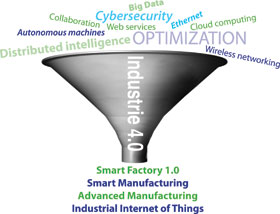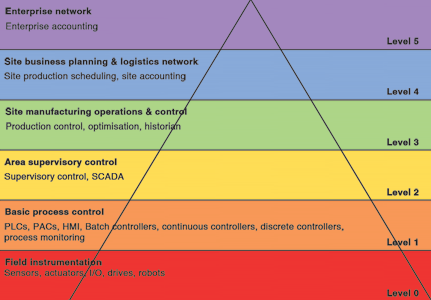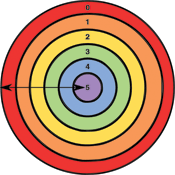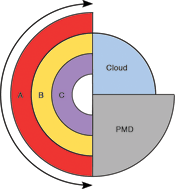

What is Industrie 4.0?
At a macro level, Industrie 4.0 is one of 10 initiatives (‘Future Projects’) identified by the German government, academia, research organisations and manufacturers as part of that country’s High-Tech Strategy 2020 Action Plan, to raise the global competitiveness of the German manufacturing industry and to ensure gainful employment for the German labour force over the next 10 to 15 years and beyond.
The Industrie 4.0 initiative is technology based, building on existing strengths within the German economy such as automation and control systems, embedded systems, security solutions and business enterprise software.
The strategy proposed to reach these goals is the merging of Operational Technology (OT) and Information Technology (IT) to achieve efficiencies in energy and resource consumption, and optimal use of manufacturing assets so that goods produced in Germany can be competitive in the global market, despite relatively higher labour costs. At the same time, the technology developed under this initiative can itself become a globally exportable product or service.
There are similar, but perhaps less structured, initiatives playing out in countries such as the USA, where the buzzwords are Advanced Manufacturing and the Industrial Internet of Things (IIoT), and in China where the concepts are addressed in that country’s Smart Factory 1.0 plans.
Revolution or evolution?
Readers might ask, “If this is Industrie 4.0, then what happened to the first three versions?”
The answer is that proponents of Industrie 4.0 predict that we are at the beginning of a fourth industrial revolution, where the first was initiated by developments in the textile industry in the UK in the late 17th and early 18th centuries with the move from cottage industry to factory based industry, which was caused through the disruptive development of steam-driven machines and the Spinning Jenny; the second originated in the USA with the introduction of production lines for the manufacture of consumer goods; and the third in the 1960s with the rise in availability of silicon based electronics bringing down the cost of computing power and promoting the introduction of electronics into consumer goods and industrial products.
This fourth industrial revolution is being triggered through the mashing up of multiple technologies, many of which are available today and some of which are already pervasive. These include the Internet, wired and wireless Ethernet, near field communications, embedded systems, artificial intelligence, cloud computing and storage, microelectromechanical systems (MEMS), RFID, flexible manufacturing systems and the Internet of Things (IoT).
According to the German Research Centre for Artificial Intelligence (DFKI), this fourth industrial revolution “(is) an industrial not a political revolution ... there will be no single defining event that takes place (to initiate it), but rather a period of dynamic development.”1
Fundamental technologies
Based on the current vision of Industrie 4.0 there are some fundamental technologies that must be incorporated in any solutions and these are non-negotiable.
Internet of Things
Industrie 4.0 builds on the concept of the Internet of Things, which sees every physical object being:
* Connected – each object must have a means of communicating with all other objects.
* Identifiable – each object must have a unique identity.
* Addressable – each object must be addressable through existing naming protocols such as a uniform resource identifier (URI).
The connection method of choice is standards-based Ethernet and the unique identity of an object will typically be its IP address.
OT and IT integration
For seamless communication across the intranet / Internet, the siloed information technology solutions of the blue-collar engineering world (C&I network infrastructure, C&I data, programmable devices, drives, etc.) and those of the white-collar business IT world (business network, local and cloud storage, business analytics, inventory, billing, ERP, etc.) need to be completely integrated. At the same time, for dynamic optimisation, the business systems need to be operating in near real time.
Implications for C&I
The paradigm shifts that need to take place for implementation of Industrie 4.0 have significant impacts on C&I practitioners.
The concepts embodied in Industrie 4.0 are multidimensional and multidisciplinary, impacting the roles and relationships of IT and engineering, the ongoing applicability of the currently accepted architectural reference models and hence control system design, IT infrastructure design, product design, manufacturing workstation design, plant layout, transport between workstations and logistics.
Space prevents discussing all of the implications, but it is worth exploring what may happen to system architectures, IT infrastructure and system security, because those could influence current purchasing decisions.
System architecture
Classical reference model
A commonly accepted reference model is often depicted as a triangle broken into horizontal layers as shown in Figure 1.

That same model can be depicted as a series of concentric circles with the field instrumentation device layer (level 0) on the outside and the top level enterprise systems (level 5) at the centre. (See Figure 2)

Control system architectures based on the traditional model rely on sensor data collected at the field level flowing up through one or more hierarchical layers, some processing being performed (control intelligence being applied) at that higher level and then control output values flowing back down to actuators in the field. For short-term sensor data archiving that same sensor data might be forwarded to a scada historian.
For process optimisation some middleware or optimisation application might collect the time series of the sensor data stored in the historian, perform some optimisation algorithm on that (and perhaps other) data and then pass one or more control variables down to the scada, which in turn forwards these to a controller and ultimately to the actuator.
This architecture is heavily dependent on data flowing radially across the boundaries between layers and communication across multiple layers largely works on a store and forward principle – often relying heavily on multiple middleware applications binding the layers and performing specialised tasks such as optimisation.
Industrie 4.0 reference model – In the Industrie 4.0 world, most of the intelligence and processing migrate to the edge (level 0). Each physical object (sensor, controller, actuator, physical widgets and work station) has many self-x characteristics (self-describing, self-organising, self-controlling, self-correcting, self-regulating, self-healing, self-reconfiguring, self-learning and self-optimising).
Ethernet and IP become the great levellers and the classical reference model is flattened. Once business systems become real-time, IT and OT are merged, self-x characteristics have devolved to the edge and data is archived to cloud storage, then what is required of scada? Could traditional scada screens simply become web pages on a business system?
At present there is no formalised reference architectural model for Industrie 4.0, but it could look something like Figure 3.

In such an architecture there is far less need for data to flow across multiple layers; much more data is travelling circumferentially, between peers, rather than radially, between children and parents. (See Figure 4)

The physical IT layout could then look similar to that shown in Figure 5, in which security zones have been omitted for clarity.
Such architecture looks far-fetched, but at the 2013 Rockwell Automation Fair, Cisco’s Rob Soderbery, Senior Vice President and General Manager of Enterprise Networking Group, raised the possibility of automation controllers being embedded in industrialised Ethernet switches².
IT infrastructure
From a control systems perspective IIoT implies that every component in the control and monitoring system – every sensor, every actuator, every controller, every router, every operator interface device etc. – is Internet connected and thus has its own IP address.
Forecasts estimate that the number of Internet connected devices will reach between 263 and 50 billion3 by the year 2020. Internet Protocol version 4 (IPv4) was only capable of providing approximately 4.3 billion (232) addresses, hence the importance of IPv6, which can provide 2128 unique addresses (more than 7.9 * 1028 times as many unique addresses as IPv4). According to a Cisco infographic4, that is 100 addresses for every atom on the face of the earth.
From a manufacturing engineer’s perspective it almost certainly means that every work cell, manufacturing node and robot has an IP address and it may also means that every work piece also has an IP address. Certainly every work piece will require an identity, but in some cases that identity may be provided through an attached barcode, QRCode or RFID tag.
Even though it is likely that the majority of network traffic will be at peer levels, the vast proliferation of connected devices and hence available data is going to mandate that wired and wireless networks provide extremely high bandwidths.
Security, security, security
When everything from the coffee maker to the manufacturing robot and perhaps the vehicles in the delivery vehicle fleet are attached to the Internet with read-write permissions the possibilities for malicious attacks are multiplied.
Vendors are investing vast sums to ensure that suitable solutions are rolled out to meet these challenges, but in the context of Industrie 4.0 the responsibility for their successful implementation rests firmly with IT practitioners in the manufacturing industry.
Conclusion
While it may be too soon to try to implement Industrie 4.0 concepts across the board, product designers, manufacturing engineers, IT and C&I practitioners should be:
* doing as much as they can to keep abreast of developments in this exciting area of manufacturing;
* considering how this new perspective might help to make their organisations more productive;
* examining how they might emulate their German counterparts by applying these principles to manufacturing operations as part of a learning process;
* re-examining their prioritisation and investment in IT security infrastructure;
* aligning their purchases of C&I and IT hardware with these new paradigms.
References
1. Germany Trade & Invest, Industrie 4.0 - Smart Manufacturing For The Future; http://tinyurl.com/mt8xlrv
2. Automation.com, Is your next automation controller an Ethernet switch?; http://tinyurl.com/jwq3dtg
3. Gartner, Press release; http://tinyurl.com/q6jyk9y
4. Cisco, The Internet of Things; http://tinyurl.com/7flbk3k

About the author
Andrew Ashton has electrical, mechanical and business qualifications and has been active in automation and process control since the early 1980s. Since 1991 he has headed up a company that has developed formulation management systems for the food, pharmaceutical and chemical manufacturing industries and manufacturing solutions involving the integration of various communication technologies and databases. Developed systems address issues around traceability, systems integration, manufacturing efficiency and effectiveness. Andrew is a contributing editor for S A Instrumentation and Control.
| Tel: | +27 31 764 0593 |
| Email: | jane@technews.co.za |
| www: | www.technews.co.za |
| Articles: | More information and articles about Technews Publishing (SA Instrumentation & Control) |
© Technews Publishing (Pty) Ltd | All Rights Reserved